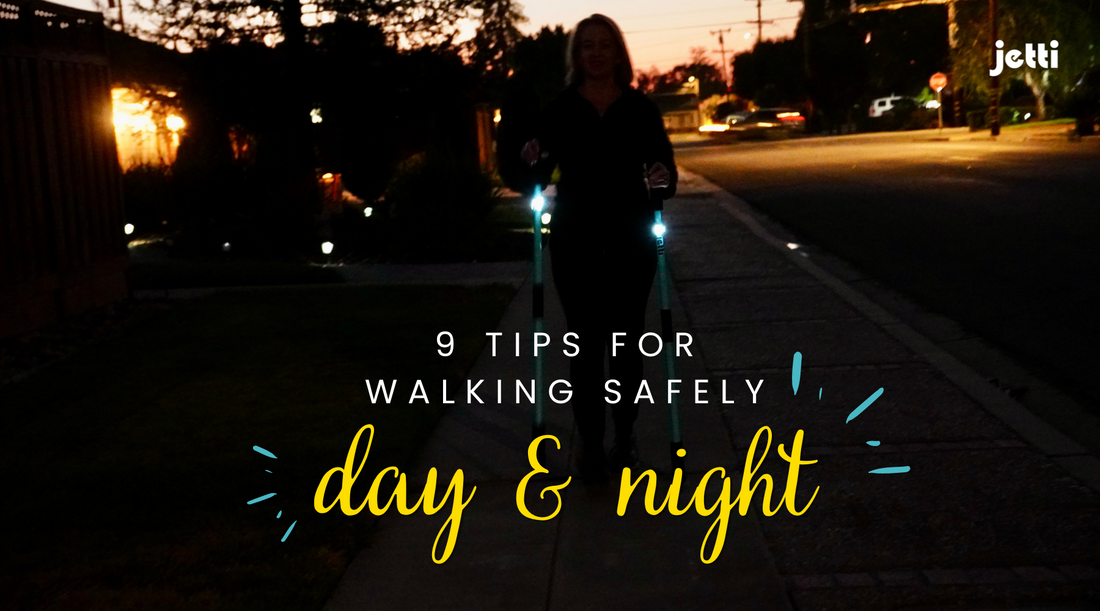Ever been out for a walk and were startled by a car zooming by? Or, been the driver of that car and didn’t see a pedestrian in your path? I remember driving home after picking my son up from soccer one evening. It was the end of a long day, and the streets were dark and quiet. I went on autopilot as I wound my way around each corner, and when it was time for me to turn onto my street, I caught a glimpse of some movement. There, dressed in all black, was someone crossing the street onto which I was about to turn. Thankfully, I was going slowly and noticed motion, but it serves as a good reminder that we all—whether on foot or wheels—should do our part to keep everyone on the roads safe.
As a pedestrian walking in dim, dark, or even daylight, it’s increasingly important to make sure you are visible to oncoming traffic with drivers’ attention being challenged by any number of distractions. In fact, statistics in the past few years have reported a dramatic increase in the number of pedestrians killed and injured by motor vehicles—a May 2022 release by the Governors Highway Safety Association estimated 7,485 people on foot in 2021.
What precautions can you take to keep safe while out for a walk day or night? Here are nine tips that you’ll want to take with you on your next outing.
- Grab a light. No matter what time of day you’re walking, adding a light to your gear can help keep you visible. A large research study on the impact of adding daytime running lights to bicycles showed a 19% decrease in accidents and injury to cyclists who had lights versus those that didn’t. It makes sense that this would also apply to pedestrians. So what’s a good way to add light? If you’re using Jetti Fitness walking poles, grab a set of Jetti Lights to add to each pole, which helps keep you visible day and night. No poles? A lightweight headlamp is super bright, and easy to strap onto your head or hat.
- Add a reflector to your back. We often think about lighting our path so we can see where we’re going, but traffic approaching from behind may not be able to see you. Try wearing a reflector on your back that will catch the light from anyone approaching you from behind.
- Gear up. Reflective vests, bands, belts and sashes will help you be seen, and a whistle will help you be heard in case of an emergency. Make sure you also have your mobile phone with you in case you need to get in touch with someone for any reason.
- Walk someplace familiar. If you’re walking in the dark, it’s not the best time to explore new terrain. Stick to places you know, which can not only help keep you from getting lost, but also help you avoid any uneven surfaces that may trip you up.
- Tell someone where you're going. Day or night, this is a good rule of thumb to follow. In case of an emergency, having someone to call or look out for you is always for the best. You may even consider bringing a friend with you and “buddying” up. After all, walking with a friend is always more fun!
- Wear bright colors. Dark colors and dim light just don’t mix. Instead, put on some brighter colors that might stand out to any oncoming traffic that might not see you if you blend into your surroundings.
- Dress for the weather. Being able to move easily is key, so you’ll want to check the weather before you head out. If it’s a scorcher, lighten up the layers, but don’t forget the sunscreen and a hat. When the sun has set, temperatures tend to dip considerably, so keep that in mind when you head out for a walk when the light is dim. Add an extra layer (or two!) of warmth to keep you cozy. Non-cotton, moisture-wicking fabric is always your best bet for physical activity in any weather.
- Walk against traffic. Just as important as it is for oncoming traffic to see you, it’s important for you to also see oncoming traffic. It helps you make sure you stay in the clear in case others on the street aren’t aware of your presence.
- Be aware. Keeping your head up and ears open while walking will help keep you safe from surprises, like other pedestrians, animals or traffic that might come out of nowhere. It may also show any onlookers that you are paying attention to your surroundings and prepared to act if necessary. If you tend to listen to music or podcasts while walking, turn your earbuds to transparency mode, or consider only using one to keep your other ear free to pick up on anything around you.
Day, night, hot or cold, a little preparation goes a long way in keeping you safe while out on a walk. As long as you follow a few safety precautions, you’ll find that nothing can stop you from getting the exercise you need to stay happy and healthy all year long.



